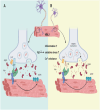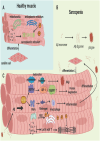Effects and mechanisms of APP and its cleavage product Aβ in the comorbidity of sarcopenia and Alzheimer's disease
- PMID: 39654807
- PMCID: PMC11625754
- DOI: 10.3389/fnagi.2024.1482947
Effects and mechanisms of APP and its cleavage product Aβ in the comorbidity of sarcopenia and Alzheimer's disease
Abstract
Sarcopenia and AD are both classic degenerative diseases, and there is growing epidemiological evidence of their comorbidity with aging; however, the mechanisms underlying the biology of their commonality have not yet been thoroughly investigated. APP is a membrane protein that is expressed in tissues and is expressed not only in the nervous system but also in the NMJ and muscle. Deposition of its proteolytic cleavage product, Aβ, has been described as a central component of AD pathogenesis. Recent studies have shown that excessive accumulation and aberrant expression of APP in muscle lead to pathological muscle lesions, but the pathogenic mechanism by which APP and its proteolytic cleavage products act in skeletal muscle is less well understood. By summarizing and analyzing the literature concerning the role, pathogenicity and pathological mechanisms of APP and its cleavage products in the nervous system and muscles, we aimed to explore the intrinsic pathological mechanisms of myocerebral comorbidities and to provide new perspectives and theoretical foundations for the prevention and treatment of AD and sarcopenia comorbidities.
Keywords: AD; amyloid precursor protein; cleavage products; intervention; myocerebral comorbidity; sarcopenia.
Copyright © 2024 Wu, Tang, Huang, Wang, Zhou, Ru, Xu, Chen and Wu.
Conflict of interest statement
The authors declare that the research was conducted in the absence of any commercial or financial relationships that could be construed as a potential conflict of interest.
Figures






References
-
- Andrade-Guerrero J., Orta-Salazar E., Salinas-Lara C., Sánchez-Garibay C., Rodríguez-Hernández L. D., Vargas-Rodríguez I., et al. . (2023a). Effects of voluntary physical exercise on the neurovascular unit in a mouse model of Alzheimer's disease. Int. J. Mol. Sci. 24:1134. doi: 10.3390/ijms241311134, PMID: - DOI - PMC - PubMed
-
- Andrade-Guerrero J., Rodríguez-Arellano P., Barron-Leon N., Orta-Salazar E., Ledesma-Alonso C., Díaz-Cintra S., et al. . (2023b). Advancing Alzheimer's therapeutics: exploring the impact of physical exercise in animal models and patients. Cells 12:2531. doi: 10.3390/cells12212531, PMID: - DOI - PMC - PubMed
Publication types
LinkOut - more resources
Full Text Sources

